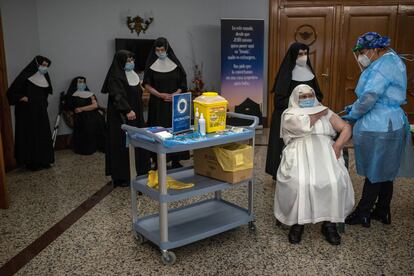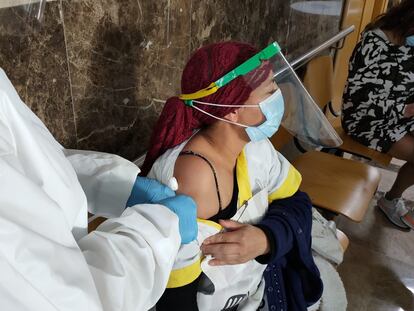Coronavirus cases up by 23,700 in a single day in Spain, with hospital pressure rising
The worsening data is likely to be underreported, given the slowdown in testing due to the recent national holidays over the Christmas season

The magnitude of the third coronavirus wave in Spain, which is being hidden by the reduced diagnostic capacity of regional health authorities due to the Christmas holiday season, is gradually becoming visible in the daily data offered by the central Health Ministry.
In the previous 24 hours, a total of 23,700 new infections were confirmed by the latest ministry report, which was released on Tuesday evening. This is not a record high for a single day, but it is close to the highest figure seen in the second wave. On October 30, for example, a total of 25,595 new coronavirus cases were reported.
Since the pandemic took hold in Spain back in March, a total of 1,982,544 official cases have been confirmed, meaning that it is very likely that on Thursday the count will have exceeded 2,000,000. Data will not be released today, Wednesday, due to the national holiday for Kings’ Day. The ministry also added 352 Covid-related deaths to the overall total in its latest report, bringing the death toll to 51,430. The real figure, however, is likely to be much higher given the number of people who died in the first wave without having been tested.
The unreliable data of recent weeks is prompting experts to look at other indicators that are less reliant on testing
The 14-day cumulative number of coronavirus cases per 100,000 inhabitants has risen 24 points on the day before to reach 296, above the extreme-risk level of 250 contemplated by the Health Ministry. This data point is also likely to be underreported given that in recent weeks the amount of testing that has been carried out has fallen considerably due to the Christmas and New Year public holidays.
Between December 11 and 24, an average of 140,000 PCR and antigen tests have been carried out in Spain, a figure that fell to 110,000 during the following seven days – a 21% fall. The diagnostic capacity has also failed to recover as the New Year has begun. According to the latest ministry report, barely 70,454 tests were carried out on Saturday.
Positivity, meanwhile – i.e. the percentage of tests coming back positive – has continued to rise in the last two weeks. At the beginning of December, the rate was below 8%, while in the last complete week published by the Health Ministry – from December 26 to January 1 – it was at 13%.
The regions that have the highest 14-day cumulative number of coronavirus cases per 100,000 inhabitants are Extremadura, with 639, the Balearic Islands (531) and Madrid (408). The best-off regions are Asturias (127), the Canaries (131) and Andalusia (155).
The unreliable data of recent weeks is prompting experts to look at other indicators, ones that are less reliant on testing, such as hospital and intensive care unit (ICU) admissions. In both cases, the rise in pressure is notable since Christmas, when the downward trend that had been seen since the peak of the second wave came to an end and the curve started to rise once more.
It is very likely that on Thursday the total case count will have exceeded 2,000,000
A total of 13,841 people were hospitalized due to Covid-19 according to Tuesday’s report, 11.4% of the total number of beds. Of these, 2,220 are in intensive care, which is 23.1% of the total. These are significant numbers and some hospitals are starting to be under stress, although the majority still have available capacity and are not nearing the maximum levels seen in March and April during the first wave. In a large part this is due to hospital stays being shorter thanks to the improvements in treatment that have been achieved over the nearly 10 months of pandemic.
The increase in both cases is nearly three percentage points. What most concerns the authorities and the experts is the change in trend and that these rises could be much greater in the coming weeks. The ministry data points to this in a number of respects.
For example, a marked rise in hospitalizations was seen on Monday, which is unusual given that patients are usually discharged on weekdays meaning that the first day of a new week normally registers a fall in hospital numbers. In the ICUs this trend was even more notable.
English version by Simon Hunter.
Tu suscripción se está usando en otro dispositivo
¿Quieres añadir otro usuario a tu suscripción?
Si continúas leyendo en este dispositivo, no se podrá leer en el otro.
FlechaTu suscripción se está usando en otro dispositivo y solo puedes acceder a EL PAÍS desde un dispositivo a la vez.
Si quieres compartir tu cuenta, cambia tu suscripción a la modalidad Premium, así podrás añadir otro usuario. Cada uno accederá con su propia cuenta de email, lo que os permitirá personalizar vuestra experiencia en EL PAÍS.
¿Tienes una suscripción de empresa? Accede aquí para contratar más cuentas.
En el caso de no saber quién está usando tu cuenta, te recomendamos cambiar tu contraseña aquí.
Si decides continuar compartiendo tu cuenta, este mensaje se mostrará en tu dispositivo y en el de la otra persona que está usando tu cuenta de forma indefinida, afectando a tu experiencia de lectura. Puedes consultar aquí los términos y condiciones de la suscripción digital.
More information
Últimas noticias
Most viewed
- Oona Chaplin: ‘I told James Cameron that I was living in a treehouse and starting a permaculture project with a friend’
- Sinaloa Cartel war is taking its toll on Los Chapitos
- Reinhard Genzel, Nobel laureate in physics: ‘One-minute videos will never give you the truth’
- Why the price of coffee has skyrocketed: from Brazilian plantations to specialty coffee houses
- Silver prices are going crazy: This is what’s fueling the rally










































